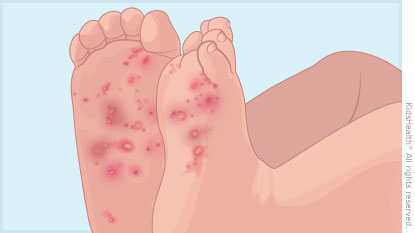Scabies
What Is Scabies?
Scabies is a common skin problem caused by tiny mites. The mites burrow into the skin, creating tiny tunnels. They lay eggs and leave poop inside the tunnels. An allergic reaction to the mite, eggs, and poop causes small itchy bumps and blisters.
What Are the Signs & Symptoms of Scabies?
The most common symptom of scabies is itching, which usually starts before any other signs. The itching can be even worse at night and can keep a person awake. Other symptoms of scabies include:
- bumps or blisters (they might look like small bug bites or pimples)
- burrow tracks (which look like wavy, raised, thread-like lines)
- thickened, scaly, scratched, and scabbed skin
- in young children, irritability and poor feeding
Scabies can show up on any part of the body but is most common on:
- the hands and feet (especially the webs of skin between the fingers and toes)
- the inner part of the wrists and the folds in the elbows and under the arms
- waistline and groin area
- in children younger than 2, on the scalp, face, neck, palms of hands, and soles of feet
It usually takes a month or two after infection for symptoms to show in someone who's never had scabies. People who have had scabies before might see symptoms in a few days.

Is Scabies Contagious?
Scabies is contagious. It spreads through close contact with someone who is infected. Direct physical contact is the most common way people get scabies. But the contact usually needs to be close and lasting, like when people live together or have sex. Quick contact, such as a brief hug, will not give the mites enough time to crawl from one person to another.
Mites can live for about 2–3 days in clothing, bedding, or dust. So people sometimes can get scabies by sharing clothing, towels, or bedding used by someone who has scabies.
Scabies spreads most easily in crowded places with a lot of close contact, such as childcare centers, college dorms, and nursing homes.
How Is Scabies Diagnosed?
Doctors usually diagnose scabies based on symptoms and how the rash looks. The doctor may scrape the skin to look for mites or eggs under a microscope.
How Is Scabies Treated?
Doctors treat scabies by prescribing a medicated cream or lotion to kill the mites. Apply the cream to skin all over the body (from the neck down), not just the area with the rash. In infants and young children, also put the cream on the face (avoiding the mouth and eyes), scalp, and ears. Trim your child's nails and also put medicine on the fingertips.
Most treatments need to stay on the skin for 8–12 hours before they're washed off. You may want to apply the medicine before your child goes to bed, then wash it off in the morning.
If treatment is effective, there should be no new rashes or burrows after 24–48 hours. The treatment may need to be repeated in 1–2 weeks. It may take 2–6 weeks after successful treatment before the itching and rash are gone.
Sometimes doctors use an oral (taken by mouth) medicine instead of skin lotion to treat scabies in older children.
The doctor might recommend an antihistamine or steroid cream, like hydrocortisone, to help with itching.
Can Scabies Be Prevented?
Household members and close contacts of someone being treated for scabies should get treated at the same time, even if they have no symptoms. This will help prevent the spread of scabies.
Wash clothing, sheets, and towels in hot water and dry on a hot setting. Put stuffed animals and any other items you can't wash in a sealed plastic bag for at least 3 days. Vacuum each room in the house, then throw away the vacuum cleaner bag.
What Else Should I Know?
Most kids can return to school the day after treatment is complete.
Scratching the itchy areas of skin can let bacteria get into the skin. The doctor will prescribe antibiotics if your child gets a skin infection. Talk to your doctor if you notice any signs of skin infection, such as redness, swelling, or pus.
